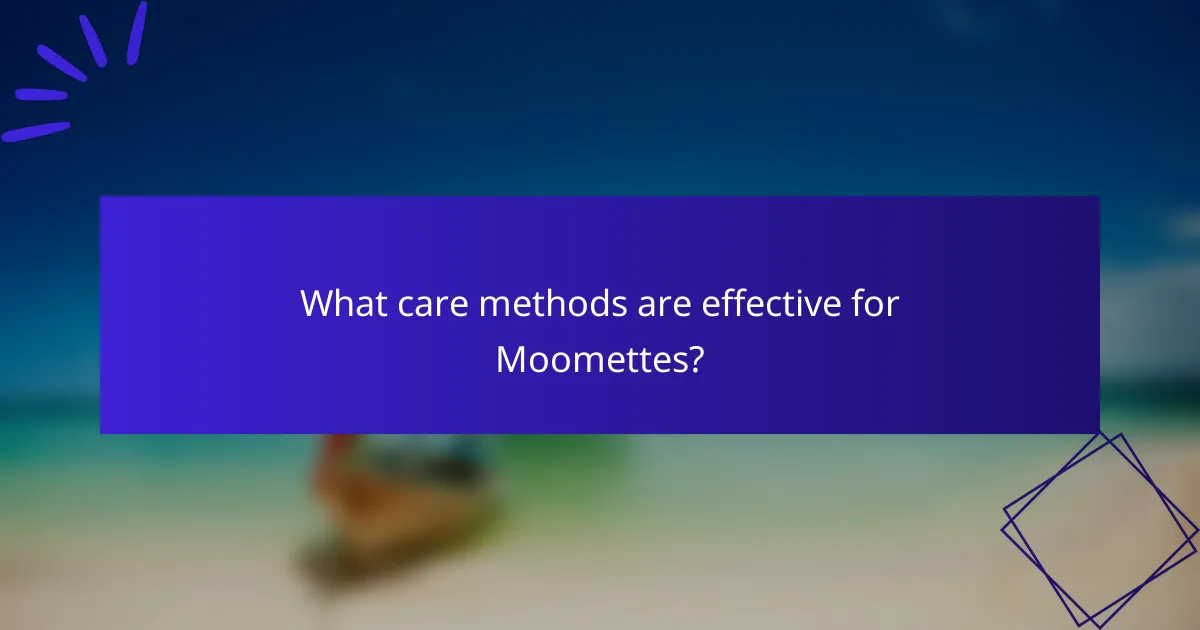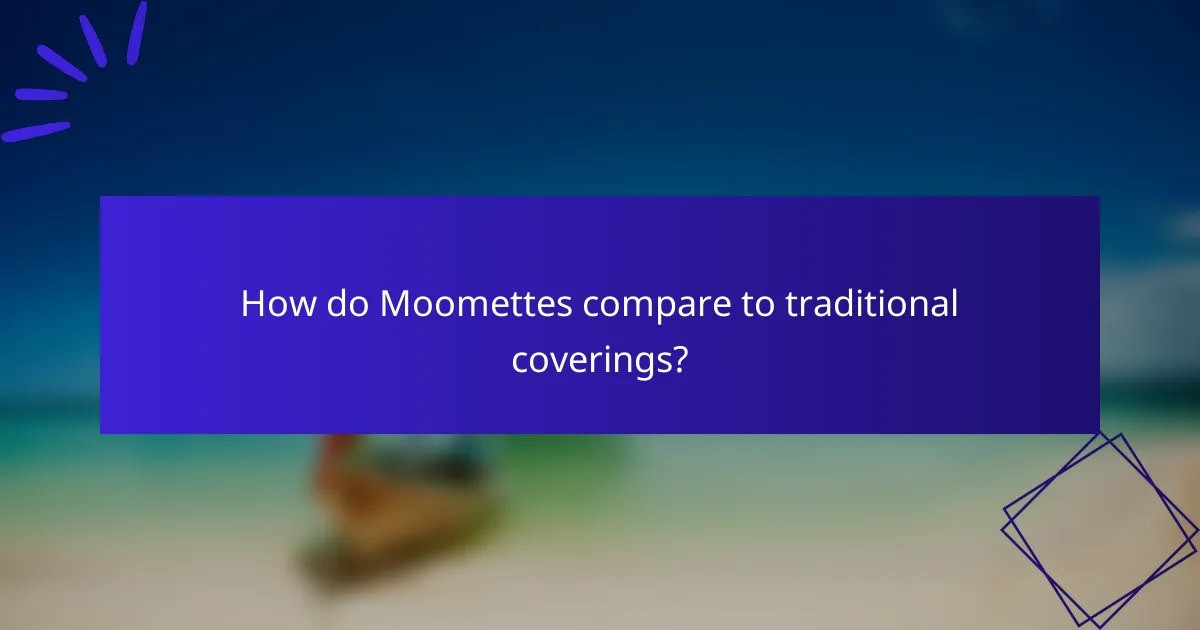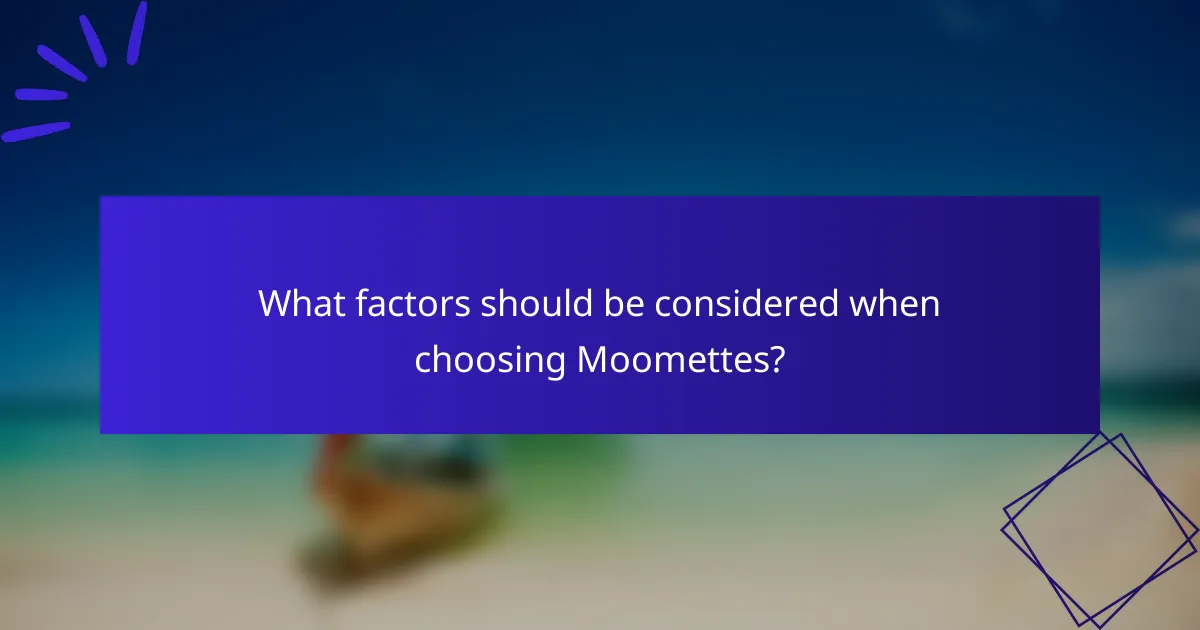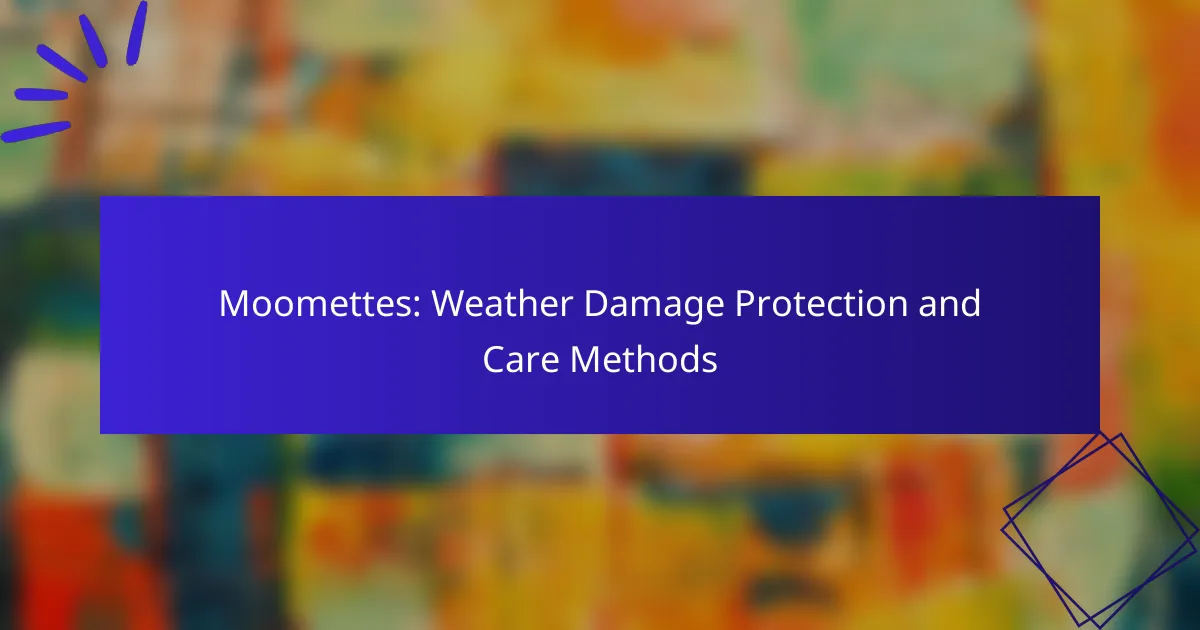Moomettes are designed to offer robust protection against weather damage, effectively shielding against moisture, UV rays, wind, and temperature changes. By implementing proper care methods, such as regular cleaning and timely repairs, homeowners can significantly enhance the durability and functionality of Moomettes, ensuring their outdoor structures remain resilient and visually appealing.

How can Moomettes protect against weather damage?
Moomettes provide effective protection against weather damage through various methods tailored to withstand moisture, UV rays, wind, and temperature fluctuations. Implementing these protective measures can significantly extend the lifespan and functionality of Moomettes in outdoor environments.
Water-resistant coatings
Water-resistant coatings are essential for preventing moisture penetration in Moomettes. These coatings create a barrier that repels water, reducing the risk of mold, mildew, and structural damage. Look for coatings that are specifically designed for outdoor use and can withstand prolonged exposure to rain and humidity.
When selecting a water-resistant coating, consider options like polyurethane or acrylic-based products, which offer durability and flexibility. Regular maintenance and reapplication every few years can help maintain their effectiveness.
UV protection treatments
UV protection treatments are crucial for safeguarding Moomettes from sun damage. These treatments help prevent fading, cracking, and degradation caused by prolonged exposure to ultraviolet rays. Products containing UV inhibitors or stabilizers can be applied to enhance the longevity of the material.
To ensure optimal protection, choose treatments that are compatible with the material of your Moomettes and reapply them as recommended, typically every one to two years, depending on environmental conditions.
Wind-resistant designs
Wind-resistant designs are vital for Moomettes to withstand strong gusts and storms. Features such as aerodynamic shapes and reinforced structures can help minimize wind resistance and prevent damage. Consider designs that have been tested against local wind standards for added assurance.
In regions prone to high winds, securing Moomettes with anchors or weights can further enhance stability. Regularly inspect these designs for wear and tear, especially after severe weather events.
Insulation enhancements
Insulation enhancements improve the thermal performance of Moomettes, protecting them from extreme temperatures. Adding insulation materials can help maintain a stable internal environment, reducing the risk of damage from freezing or overheating. Look for insulation options that are lightweight yet effective.
Common insulation materials include foam boards or reflective barriers. Ensure that the insulation is properly installed to avoid gaps that could compromise its effectiveness.
Drainage systems
Effective drainage systems are crucial for preventing water accumulation around Moomettes. Proper drainage helps avoid issues like flooding and erosion, which can lead to significant damage over time. Incorporating features such as sloped surfaces or drainage channels can facilitate water runoff.
When designing drainage systems, consider local rainfall patterns and soil types to ensure adequate water management. Regularly check and maintain these systems to prevent blockages and ensure optimal performance.

What care methods are effective for Moomettes?
Effective care methods for Moomettes include regular cleaning, seasonal maintenance, and prompt repair techniques for any damage. These practices help ensure the longevity and functionality of Moomettes, protecting them from weather-related issues.
Regular cleaning protocols
Regular cleaning is essential for maintaining Moomettes in optimal condition. Use a soft brush or cloth to remove dirt and debris, ensuring that no abrasive materials are used that could scratch the surface. Aim to clean them at least once a month, especially after heavy storms or windy conditions.
For deeper cleaning, consider using a mild detergent mixed with water. Rinse thoroughly to prevent any soap residue from causing damage. Avoid harsh chemicals that can degrade the materials over time.
Seasonal maintenance tips
Seasonal maintenance is crucial for Moomettes, particularly before and after extreme weather conditions. In spring, inspect for any wear and tear from winter, and ensure that all seals and joints are intact. This can help prevent leaks or structural damage during heavy rains.
In autumn, prepare Moomettes for winter by checking for loose components and reinforcing any weak areas. If you live in a region with heavy snowfall, consider applying a protective coating to prevent ice buildup.
Repair techniques for damage
Promptly addressing any damage to Moomettes is vital for their longevity. For minor scratches or dents, use a suitable filler or sealant to restore the surface. Ensure the area is clean and dry before applying any repair materials.
For more significant damage, such as cracks or structural issues, it may be necessary to consult a professional. Regularly assess the integrity of Moomettes to catch problems early, which can save on costly repairs later.

What are the benefits of using Moomettes?
Moomettes provide significant advantages in protecting property from weather damage, enhancing aesthetics, and increasing overall value. By utilizing Moomettes, homeowners can ensure their structures remain resilient against various environmental factors while also improving their appeal and market worth.
Extended lifespan
Using Moomettes can significantly extend the lifespan of your property by shielding it from harsh weather conditions such as heavy rain, snow, and UV rays. This protective layer helps prevent deterioration of materials, reducing the need for frequent repairs and replacements.
Regular maintenance of Moomettes, including inspections and timely repairs, can further enhance their effectiveness. Homeowners should consider seasonal checks to ensure that Moomettes remain intact and functional, which can lead to long-term savings on maintenance costs.
Improved aesthetic appeal
Moomettes can enhance the visual appeal of a property by providing a clean, uniform look that complements various architectural styles. They come in various colors and designs, allowing homeowners to choose options that match their personal taste and the overall theme of their property.
Incorporating Moomettes into your property can also create a more inviting atmosphere, which is particularly beneficial if you plan to sell. A well-maintained exterior can attract potential buyers and make a lasting impression.
Increased property value
Investing in Moomettes can lead to an increase in property value, as they contribute to both the structural integrity and visual appeal of a home. Properties that are well-protected and aesthetically pleasing often command higher prices in the real estate market.
Homeowners should keep in mind that the return on investment for Moomettes can vary based on location and market conditions. However, properties with enhanced weather protection and improved aesthetics typically see a favorable increase in value, making Moomettes a wise investment.

How do Moomettes compare to traditional coverings?
Moomettes offer several advantages over traditional coverings, including enhanced protection against weather damage and ease of use. While traditional coverings may be less expensive upfront, Moomettes often provide better long-term value due to their durability and lower maintenance needs.
Cost-effectiveness
Moomettes can be more cost-effective in the long run compared to traditional coverings. Although the initial investment may be higher, their longevity and reduced need for repairs can offset these costs. For instance, Moomettes may last several years longer than standard tarps or covers, which often need replacement every season.
When evaluating cost-effectiveness, consider both the purchase price and the potential savings on maintenance and replacement. In many cases, spending a bit more upfront can lead to significant savings over time.
Durability comparison
Moomettes are designed to withstand harsh weather conditions better than traditional coverings. Made from advanced materials, they resist tearing, fading, and water damage more effectively. This durability means they can endure heavy rain, snow, and UV exposure without significant wear.
In contrast, traditional coverings often degrade quickly under similar conditions, leading to more frequent replacements. For example, a standard tarp might last one to two seasons, while a Moomette could last three to five years or more, depending on usage and environmental factors.
Maintenance requirements
Maintaining Moomettes is generally simpler than caring for traditional coverings. They typically require less frequent cleaning and can often be hosed down to remove dirt and debris. This ease of maintenance saves time and effort, making them a practical choice for busy users.
Traditional coverings, on the other hand, may need regular inspections for damage and more extensive cleaning to prevent mold and mildew. Users should be prepared for the additional labor involved in maintaining these older options, which can detract from their overall convenience.

What factors should be considered when choosing Moomettes?
When selecting Moomettes for weather damage protection, consider climate conditions, material types, and installation methods. Each factor plays a critical role in ensuring effective protection and longevity of the Moomettes.
Climate suitability
Climate suitability is essential when choosing Moomettes, as different materials perform better in specific weather conditions. For instance, areas with high humidity may require breathable fabrics to prevent mold, while regions prone to heavy snowfall need robust, insulated options.
Evaluate local weather patterns, including temperature ranges and precipitation levels, to determine the best Moomette type. Consulting local weather data can help in making an informed choice that aligns with your environment.
Material options
Moomettes are available in various materials, each offering unique benefits. Common options include polyester for its durability, cotton for breathability, and specialized synthetic fabrics for waterproofing.
When selecting materials, consider factors such as ease of maintenance, resistance to UV rays, and overall lifespan. For example, while cotton is comfortable, it may not withstand harsh weather as well as synthetic alternatives.
Installation methods
Installation methods for Moomettes can vary significantly based on the design and material. Common techniques include using hooks, grommets, or Velcro strips, each offering different levels of ease and security.
Evaluate the installation process for your chosen Moomettes to ensure it aligns with your skill level and available tools. Proper installation is crucial for maximizing protection against weather damage, so follow manufacturer guidelines closely.
